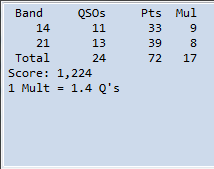This past weekend, late in the evening, as I was fiddling around with the ATS-4 seeing how the bands were doing, I ran across a particularly strong CW signal on 10.116 MHz, near the bottom of the 30m band. It turned out to be the end of a QSO between KA7OGK and W5IP, the latter of whom was coming in 5-by-8 here in Chicago. When they wrapped up their conversation, I through out a quick call to W5IP, and she came back! I could tell that Carroll (whose name I’d gleaned from the earlier conversation) was heading out, as our exchange was much more perfunctory than conversational. But it allowed me to put my first 30m contact (as well as my first Texas station, as it turns out).
And with that, I’ve now made a contact on every band I currently have access to – 80m, 40m, 30m, 20m, and 15m! So far 40m and 20m have proved to be my workhorse bands, but some late-night exploration makes me think I should be paying more attention to 80m later in the evening.
With the new 30m Texas contact, and one with a nice Louisiana ham this morning (WB5WDC, retired petroleum engineer who used to work not far from Chicago in Crystal Lake), my total number of states worked is up to 10: Arizona, California, Colorado, Louisiana, North Carolina, New York, Pennsylvania, Texas, and Virginia:

Until I can put a longer or more-vertical Antenna in the air, I don’t think I’ll be chasing foreign counties for a little while, but Worked-All-States seems like an achievable short-term goal. Of course, of the 10 states I’ve worked, I only have confirmation from California and Pennsylvania, so there’s a way to go yet. But I’m having a great time acquiring my own “All Time New One” states.
Hear you on the air!
73






